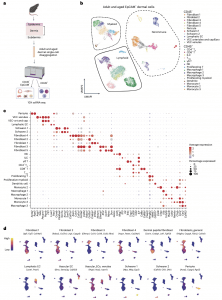In a recent study, scientists have discovered that the IL-17 protein plays a crucial role in the aging process of the skin (Figure 1). They found that IL-17 is involved in various functions related to skin aging and that blocking its function can slow down the appearance of age-related skin deficiencies. This finding opens new possibilities for treating symptoms associated with aging skin and aiding in skin recovery after surgery.

Figure 1: Dermal cell characterization by 10X scRNA-seq. a, Workflow used to obtain dermal cells of adult and aged mouse back skin. Single-cell suspensions were enriched separately for EpCAM – CD45– and CD45+ cells by FACS. Transcriptomes of sorted single cells were then analyzed by 10X scRNA-seq. For CD45+ cells, n = 7 mice for the adult group and n = 4 mice for the aged group, with three technical replicates: for CD45 –EpCAM– cells, n = 2 mice for the control group and n = 2 mice for the aged group, with two technical replicates. Created with BioRender.com. b, UMAP visualization of all adult and aged dermal cells analyzed by 10X scRNA-seq. c, Dot plot showing discriminatory markers for each cell type, subtype and state found in b. d, UMAP visualization of nonimmune cell subtype-specific signatures. EC, endothelial cells; VEC, vascular endothelial cells.
The research utilized single cell sequencing to explore the complex composition of cell types in the skin and how they change over time. Alongside epithelial cells and hair follicle cells, the skin contains immune cells that play a vital role in infection prevention and protection against damage. The study revealed that certain immune cells, such as gamma delta T cells, innate lymphoid cells, and CD4+ T cells, significantly increase in number within the skin during aging. Moreover, these cells begin to express high levels of IL-17, which is a pro-inflammatory cytokine.
Moving forward, the researchers plan to further investigate the relationship between inflammatory states, aging processes, and IL-17 in the skin. They also aim to explore whether IL-17 is involved in the aging and deterioration of other tissues and organs.
In summary, the study highlights the central role of IL-17 protein in skin aging and its contribution to an inflammatory state. By understanding the mechanisms behind IL-17 and its impact on aging, researchers hope to develop new strategies for managing age-related skin conditions and promoting skin recovery.
Journal article: Solá, P, et al., 2023. Targeting lymphoid-derived IL-17 signaling to delay skin aging. Nature Aging.
Summary by Stefan Botha










